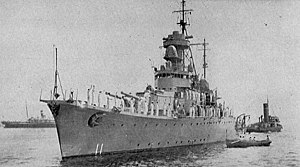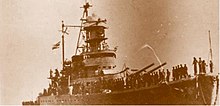HTMS Thonburi
 Thonburi in 1938
| |
| History | |
|---|---|
| Name | HTMS Thonburi |
| Namesake | Kingdom of Thonburi |
| Awarded | |
| Builder | Kawasaki Co |
| Laid down | 12 January 1936 |
| Launched | 31 July 1937 |
| Commissioned | 31 January 1938 |
| Decommissioned | 26 September 1941 |
| Stricken | 19 June 1959 |
| Fate | Wrecked in Battle of Koh Chang on 17 January 1941, refitted in Japan, decommissioned and used as a training vessel until being stricken. |
| Status | Become a memorial site (deck & front turret) at Royal Thai Naval Academy, Samut Prakan. |
| General characteristics | |
| Class and type | Template:Sclass- |
| Displacement | 2,265 tons |
| Length | 252.66 ft (77.01 m) |
| Beam | 47.25 ft (14.40 m) |
| Draft | 13.75 ft (4.19 m) |
| Propulsion | |
| Speed | 15.5 knots |
| Complement | 234 officers and men |
| Armament |
|
| Armor |
|
HTMS Thonburi, also known as Dhonburi, was a coastal defence ship of the Royal Thai Navy.
Design

Thonburi and her sister ship, HTMS Sri Ayudhya, were designed following the incorporation of the earlier Template:Sclass-s into the Siamese Navy in the 1920s. The Ratanakosindra class were British-built ships which featured six-inch guns in two turrets and light armor. Under Plaek Pibulsonggram's command, the Siamese Navy began a series of modernization efforts. Priorities for the navy consisted of protecting the extensive Thai coastline, and coastal gunboats were viewed as the best resource. Several foreign firms from European countries offered a variety of designs, but in the end the Japanese company Kawasaki won the tender.
The new vessels were basically larger versions of the earlier Ratanakosindra ships. The ships were laid down at Kawasaki's facilities in 1936, and the first, Sri Ayuthia, was launched on 21 July 1937. The resulting "battleships," as they were referred to in Siam at the time, displaced 2,265 tons, featured increased armor protection (protecting machinery and gun turrets), and were powered by twin diesels produced by MAN of Germany.
Armament consisted of four 8-inch (203 mm)/50 calibre guns mounted in pairs in two turrets. The Japanese 8-inch rifles were of the same type as mounted in early Imperial Japanese Navy heavy cruisers and the aircraft carriers Akagi and Kaga. The main armament had a maximum range of 24,000 metres (26,000 yd) at 25 degrees of elevation. A tower above the bridge featured a gun director for aiming the main guns. Additional armament consisted of four 3-inch and four 40-mm guns.
The new ships were enthusiastically received by the Siamese Navy. Purchasing further vessels of the type was considered by the government, but ultimately it was decided to purchase two Italian-built light cruisers in 1938. Both ships were seized by Italy in 1941 before construction had finished (they were never completed), leaving Thonburi and her sister ship as the most powerful combatants in Siamese service.
Service

Both ships of the class had entered service by the time hostilities had broken out in Europe during the Second World War. Thonburi engaged a Vichy French squadron in the Battle of Koh Chang on 17 January 1941. The resulting battle was nothing short of a massive defeat, as the Siamese ship was severely damaged by enemy fire and beached to prevent sinking. Thonburi was later raised and attempts were made to repair the extensive damage and continued to serve the navy as a training vessel until being stricken in 1959. Part of her bridge and forward gun turret are preserved as a memorial at the Royal Thai Naval Academy. Sri Ayuthia had a rather more unfortunate fate. She was sunk in 1951 during an attempted coup.
References
- ^ "แจ้งความสำนักนายกรัฐมนตรี เรื่อง พระราชทานเหรียญกล้าหาญ. 26 สิงหาคม 2484" ราชกิจจานุเบกษา. 58 (2 กันยายน 2484) : 2810-2811.
